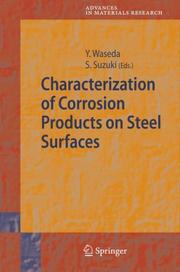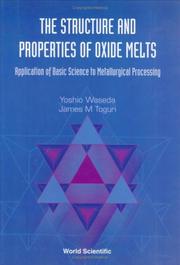| Listing 1 - 10 of 11 | << page >> |
Sort by
|
Book
ISBN: 3540133593 0387133593 3540389105 Year: 1984 Publisher: Berlin ; New York : Springer-Verlag,
Abstract | Keywords | Export | Availability | Bookmark
 Loading...
Loading...Choose an application
- Reference Manager
- EndNote
- RefWorks (Direct export to RefWorks)
X-rays --- Rayons X --- Ordre et désordre (physique) --- Order-disorder models. --- Scattering. --- Diffusion. --- Ordre et désordre (physique)

ISBN: 1280635347 9786610635344 3540351787 3540351779 3642421539 Year: 2006 Volume: 7 Publisher: Berlin ; [Great Britain] : Springer,
Abstract | Keywords | Export | Availability | Bookmark
 Loading...
Loading...Choose an application
- Reference Manager
- EndNote
- RefWorks (Direct export to RefWorks)
It is well known that corrosion products, i.e. rust, on iron and steel surfaces cannot be assigned a typical crystallographic structure with long-range order. In fact, the structure of rust is considered to be very complicated, and some forms of rust are assigned to the amorphous state for this reason. Accurate information about the atomic-scale structure of rust is important to shed light on corrosion mechanisms of metallic materials. And, since life of steel structures is often dominated by environmental degradation or corrosion of the surface, the structure of the rust formed on iron and steel surfaces during prolonged exposure to air is of great interest. This book describes the fundamental aspects of materials characterization for the ferric oxyhydroxides formed on steel surfaces. Selected examples, from both the basic science and the applied engineering points of view, are presented. Of special interest is the new structural information on ferric oxyhydroxides containing a small amount of alloying elements. The text relates this to their various states and their role in corrosion processes. This monograph will serve as a valuable guide and source of information for specialists and non-specialists alike.
Steel --- Corrosion and anti-corrosives. --- Corrosion. --- Anti-corrosive paint --- Atmospheric corrosion --- Metal corrosion --- Metals --- Rust --- Rustless coatings --- Chemical inhibitors --- Chemistry, Technical --- Fouling --- Materials --- Weathering --- Paint --- Protective coatings --- Waterproofing --- Corrosion --- Deterioration --- Surfaces --- Materials. --- Metallic Materials. --- Engineering --- Engineering materials --- Industrial materials --- Engineering design --- Manufacturing processes --- Metals. --- Metallic elements --- Chemical elements --- Ores --- Metallurgy
Book
ISBN: 3540859179 9786611950989 128195098X 3540859187 Year: 2009 Publisher: Berlin : Springer,
Abstract | Keywords | Export | Availability | Bookmark
 Loading...
Loading...Choose an application
- Reference Manager
- EndNote
- RefWorks (Direct export to RefWorks)
Thermophysical properties of high-temperature materials are important from both the scientific and engineering points of view. This book includes the latest developments in the measurements of atomic structure, density, surface tension, viscosity, heat capacity, thermal and mass diffusivity, thermal conductivity, emissivity, and electrical conductivity of mainly metallic melts. High-temperature measurements are difficult due to high chemical reactivity and fluidity. Some distinctive inventions on the experimental techniques such as levitation technique combined with microgravity, synchrotron radiation or magnetic field enable high-precision measurements. This book is the perfect choice for specialists and nonspecialists eager to know the cutting-edge details in this field.
Materials at high temperatures. --- Materials --Thermal properties. --- Materials --- Materials at high temperatures --- Materials Science --- Chemical & Materials Engineering --- Engineering & Applied Sciences --- Thermal properties --- Thermal properties. --- Thermophysical properties --- Materials science. --- Thermodynamics. --- Engineering. --- Metals. --- Materials Science. --- Materials Science, general. --- Metallic Materials. --- Engineering, general. --- High temperatures --- Strength of materials
Digital
ISBN: 9783540351788 Year: 2006 Publisher: Berlin, Heidelberg Springer
Abstract | Keywords | Export | Availability | Bookmark
 Loading...
Loading...Choose an application
- Reference Manager
- EndNote
- RefWorks (Direct export to RefWorks)

ISBN: 9812816674 9789812816672 9810233175 9789810233174 Year: 1998 Publisher: Singapore ; River Edge, NJ : World Scientific,
Abstract | Keywords | Export | Availability | Bookmark
 Loading...
Loading...Choose an application
- Reference Manager
- EndNote
- RefWorks (Direct export to RefWorks)
This book is an extended introductory treatise on the atomic scale structure and physicochemical properties of oxide melts (mainly silicates), from both the basic science and applied engineering points of view. It provides current experimental information on the structure of oxide melts and glasses as well as a convenient outline of their various physicochemical properties, including the subject of how structural data can be correlated with their macroscopic properties.The book also includes a fundamental introduction to the beneficial utilization of waste oxides largely arising from metal pro
Chemistry, Metallurgic. --- Metal wastes. --- Oxides. --- Silicates. --- Oxygen compounds --- Silicon compounds --- Chalcogenides --- Metal-containing wastes --- Metallurgical wastes --- Waste metals --- Wastes, Metal --- Wastes, Metallurgical --- Factory and trade waste --- Metallurgic chemistry --- Chemistry, Technical
Book
ISBN: 3642442552 3642166342 9786613081940 3642166350 1283081946 Year: 2011 Publisher: Berlin : Springer,
Abstract | Keywords | Export | Availability | Bookmark
 Loading...
Loading...Choose an application
- Reference Manager
- EndNote
- RefWorks (Direct export to RefWorks)
X-ray diffraction crystallography for powder samples is a well-established and widely used method. It is applied to materials characterization to reveal the atomic scale structure of various substances in a variety of states. The book deals with fundamental properties of X-rays, geometry analysis of crystals, X-ray scattering and diffraction in polycrystalline samples and its application to the determination of the crystal structure. The reciprocal lattice and integrated diffraction intensity from crystals and symmetry analysis of crystals are explained. To learn the method of X-ray diffraction crystallography well and to be able to cope with the given subject, a certain number of exercises is presented in the book to calculate specific values for typical examples. This is particularly important for beginners in X-ray diffraction crystallography. One aim of this book is to offer guidance to solving the problems of 90 typical substances. For further convenience, 100 supplementary exercises are also provided with solutions. Some essential points with basic equations are summarized in each chapter, together with some relevant physical constants and the atomic scattering factors of the elements.
Crystallography. --- Engineering. --- Materials. --- Surfaces (Physics). --- X-ray crystallography --- Chemical & Materials Engineering --- Engineering & Applied Sciences --- Materials Science --- X-ray crystallography. --- Materials science. --- Solid state physics. --- Spectroscopy. --- Microscopy. --- Nanotechnology. --- Materials Science. --- Characterization and Evaluation of Materials. --- Nanotechnology and Microengineering. --- Solid State Physics. --- Spectroscopy and Microscopy. --- Crystallography --- Crystallography and Scattering Methods. --- Construction --- Industrial arts --- Technology --- Leptology --- Physical sciences --- Mineralogy --- Physics --- Surface chemistry --- Surfaces (Technology) --- Analysis, Spectrum --- Spectra --- Spectrochemical analysis --- Spectrochemistry --- Spectrometry --- Spectroscopy --- Chemistry, Analytic --- Interferometry --- Optics --- Radiation --- Wave-motion, Theory of --- Absorption spectra --- Light --- Spectroscope --- Solids --- Molecular technology --- Nanoscale technology --- High technology --- Analysis, Microscopic --- Light microscopy --- Micrographic analysis --- Microscope and microscopy --- Microscopic analysis --- Optical microscopy --- Material science --- Qualitative --- Analytical chemistry
Book
ISBN: 9783540351788 Year: 2006 Publisher: Berlin, Heidelberg Springer
Abstract | Keywords | Export | Availability | Bookmark
 Loading...
Loading...Choose an application
- Reference Manager
- EndNote
- RefWorks (Direct export to RefWorks)
It is well known that corrosion products, i.e. rust, on iron and steel surfaces cannot be assigned a typical crystallographic structure with long-range order. In fact, the structure of rust is considered to be very complicated, and some forms of rust are assigned to the amorphous state for this reason. Accurate information about the atomic-scale structure of rust is important to shed light on corrosion mechanisms of metallic materials. And, since life of steel structures is often dominated by environmental degradation or corrosion of the surface, the structure of the rust formed on iron and steel surfaces during prolonged exposure to air is of great interest. This book describes the fundamental aspects of materials characterization for the ferric oxyhydroxides formed on steel surfaces. Selected examples, from both the basic science and the applied engineering points of view, are presented. Of special interest is the new structural information on ferric oxyhydroxides containing a small amount of alloying elements. The text relates this to their various states and their role in corrosion processes. This monograph will serve as a valuable guide and source of information for specialists and non-specialists alike.
Book
ISBN: 9783540859185 Year: 2009 Publisher: Berlin Heidelberg Springer Berlin Heidelberg
Abstract | Keywords | Export | Availability | Bookmark
 Loading...
Loading...Choose an application
- Reference Manager
- EndNote
- RefWorks (Direct export to RefWorks)
Thermophysical properties of high-temperature materials are important from both the scientific and engineering points of view. This book includes the latest developments in the measurements of atomic structure, density, surface tension, viscosity, heat capacity, thermal and mass diffusivity, thermal conductivity, emissivity, and electrical conductivity of mainly metallic melts. High-temperature measurements are difficult due to high chemical reactivity and fluidity. Some distinctive inventions on the experimental techniques such as levitation technique combined with microgravity, synchrotron radiation or magnetic field enable high-precision measurements. This book is the perfect choice for specialists and nonspecialists eager to know the cutting-edge details in this field.
Thermodynamics --- Metals and their compounds --- Materials sciences --- Engineering sciences. Technology --- thermodynamica --- materiaalkennis --- ingenieurswetenschappen --- metalen
Digital
ISBN: 9783642166358 Year: 2011 Publisher: Berlin, Heidelberg Springer Berlin Heidelberg
Abstract | Keywords | Export | Availability | Bookmark
 Loading...
Loading...Choose an application
- Reference Manager
- EndNote
- RefWorks (Direct export to RefWorks)
Optics. Quantum optics --- Solid state physics --- Chemical structure --- Theoretical spectroscopy. Spectroscopic techniques --- Chemical and physical crystallography --- Materials sciences --- Biotechnology --- kristallografie --- vaste stof --- materiaalkennis --- materie (fysica) --- nanotechniek --- spectroscopie --- biotechnologie --- microscopie
Book
ISBN: 9783642166358 Year: 2011 Publisher: Berlin, Heidelberg Springer Berlin Heidelberg
Abstract | Keywords | Export | Availability | Bookmark
 Loading...
Loading...Choose an application
- Reference Manager
- EndNote
- RefWorks (Direct export to RefWorks)
X-ray diffraction crystallography for powder samples is a well-established and widely used method. It is applied to materials characterization to reveal the atomic scale structure of various substances in a variety of states. The book deals with fundamental properties of X-rays, geometry analysis of crystals, X-ray scattering and diffraction in polycrystalline samples and its application to the determination of the crystal structure. The reciprocal lattice and integrated diffraction intensity from crystals and symmetry analysis of crystals are explained. To learn the method of X-ray diffraction crystallography well and to be able to cope with the given subject, a certain number of exercises is presented in the book to calculate specific values for typical examples. This is particularly important for beginners in X-ray diffraction crystallography. One aim of this book is to offer guidance to solving the problems of 90 typical substances. For further convenience, 100 supplementary exercises are also provided with solutions. Some essential points with basic equations are summarized in each chapter, together with some relevant physical constants and the atomic scattering factors of the elements.
Optics. Quantum optics --- Solid state physics --- Chemical structure --- Theoretical spectroscopy. Spectroscopic techniques --- Chemical and physical cristallography --- Materials sciences --- Biotechnology --- kristallografie --- vaste stof --- materiaalkennis --- materie (fysica) --- nanotechniek --- spectroscopie --- biotechnologie --- microscopie
| Listing 1 - 10 of 11 | << page >> |
Sort by
|

 Search
Search Feedback
Feedback About UniCat
About UniCat  Help
Help News
News